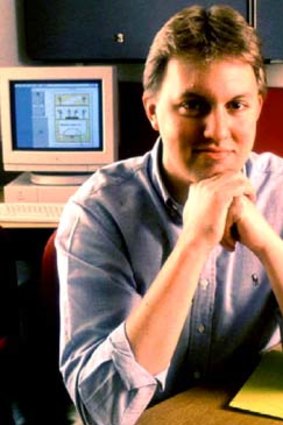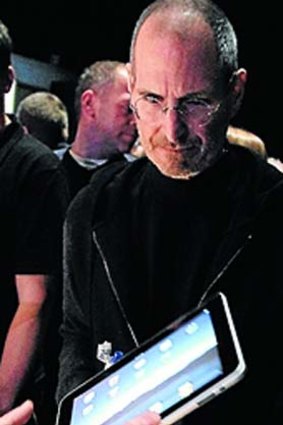This was published 12 years ago
Why the web needs HTML5
The language of cyberspace is evolving slowly to a rich, promising new standard.
By Samantha Amjadali
HTML5. It's a tiny, geeky, programming term of seemingly little consequence, yet to the chieftains of the internet and the world's biggest software companies, it poses the crux of a rather gargantuan question: who should own the code that runs cyberspace?
Yes, it all sounds rather dramatic but, this time, the hype is warranted.

Phones and tablets are held aloft to salute the father of the web, Sir Tim Berners-Lee, at a conference in Spain.
The internet is one of humanity's greatest inventions and, certainly, one of our greatest resources. Naturally, everybody wants a piece but nobody owns it. Nobody can.
It's a bubbling hotchpotch of billions of pages of content, hosted on hundreds of millions of servers run by tens of millions of individuals - but what you can own is the base code that runs it all, HTML, the programming language upon which the internet is built.

Netscape's Marc Andreessen in his office that contains a 1990s PC when the web was in its infancy.
HTML stands for hypertext markup language. It is, in effect, the web's DNA and creates a global system for identifying and linking web pages. When you click on a hyperlink to visit a website, the HTML kicks in, finds the subject of the link and transports users, seamlessly and in seconds, to the target page, which may be located on a computer many hundreds or thousands of kilometres away, or just around the corner.
HTML appeared in 1990, the result of British physicist and computer programmer Tim Berners-Lee's realisation that the creation of a simple, open standard could enable humanity to pool and share its knowledge via a web of hypertext documents.
As brilliant programmers do, Berners-Lee set about coding his epiphanic vision in 1989 and, within a year, he had found a way to successfully communicate between a hypertext transfer protocol client and a server, creating the first web page.
The result was HTML.

Sir Tim Berners-Lee, the creator of HTML5, addresses a conference in London.
Two decades later, the scientist is known as Sir Tim and his web has exploded in size, depth, capability and influence; however, HTML hasn't necessarily kept up. Much of the growth and innovation on the internet has been driven by an odd, often-incompatible hotchpotch of open standards such as newer incarnations and extensions of HTML, including XML (extensible markup language) and CSS (cascading style sheets), but also proprietary technology such as Adobe's Flash, Oracle's JavaScript and Microsoft's Silverlight, which add functionality such as animation and interactivity to the base open standards.
HTML5 drags HTML into the 21st century, allowing programmers to create richly interactive environments natively within browsers, effectively side-stepping the need for proprietary plug-ins from companies such as Adobe and Microsoft.

Apple's Steve Jobs with the original iPad.
Naturally, its development has raised the chagrin - and ire - of some of the world's most influential software companies, all of whom reckon, even secretly, they should own, or at the very least control, the code that runs cyberspace, whatever form that may take.
Included in the list of new features in HTML5 are native audio, video and animations, as well as vastly improved error handling, ''web workers'' (which bring multithreading capabilities to HTML) and, most lauded, the Canvas, which allows real-time rendering of graphics.
''HTML was always very limited and rudimentary and, in the beginning, you didn't even have the ability to change background colours and it was just about making documents available to other people,'' says Lawrence Cooke, a developer for Xazz Creative, a Tasmanian web-development agency.
''HTML5 has certainly made things more interesting for web developers. Its new tags make it very different from previous versions and, as a developer, we can now do very complex things, such as creating a full game natively within the browser.
''It's a huge step, mainly in entertainment, but it gives developers a whole other level of control and interactivity and means we can be more creative.''
Cooke, who has been developing websites since the early 1990s, has worked with every version of HTML released and says his current frustration with the as-yet-unfinished HTML5 standard is that all the major browsers support HTML5 differently, leading to unpredictability for developers.
It's a widespread opinion, one that only props up the arguments of plug-in vendors such as Adobe who, naturally, argue the need for private companies to continue developing proprietary web standards.
''The internet and the web have always had a mixture of standardised technologies and proprietary technologies,'' says HTML5 specifications editor Ian Hickson, a Californian.
''Innovation happens in proprietary technologies, which can move faster and don't have to be as well defined. Standards then follow up and sweep in all the good ideas, defining them in enough detail that we can get multiple implementations that actually work together.''
Without an open standard, Hickson says, ''we need multiple implementations of the tools we use to browse the web. Multiple browsers, multiple servers, multiple authoring tools, multiple device vendors, multiple networks: the system has to be vendor-neutral across the entire stack.
''When you have multiple implementations, you need something that describes how those implementations are to work. That's what web standards are.''
Given the internet's unparalleled importance to humanity, should it be regulated by a single body? Should it be run on an open standard? Should private companies be allowed to control large swaths of cyberspace using technology that only they own?
The problem is everybody is asking these same questions but there is no answer.
Sir Tim and his knights of the round table of open standards will say, unequivocally, no, private companies shouldn't take control, while representatives from the software companies fervently argue that a fusion of open and proprietary standards is necessary to foster growth and innovation - and speed up the harmonisation process.
The HTML5 standards won't be finalised until 2014, a decade after the standard was first proposed.
By that time, the likes of Adobe and Microsoft will have released multiple, and vastly improved, versions of their own proprietary web technology.
The situation is compounded by the existence of at least five major browsers, created by Google (Chrome), Apple (Safari), Microsoft (Internet Explorer), Mozilla (Firefox) and Opera.
As noted by Cooke, each has its own way of reading and implementing various web standards and the absence of a global web standard means a single website could be experienced differently depending on which browser is used.
''Proprietary software seems to move faster because the company only needs to please itself and its shareholders,'' says Bruce Lawson, a British co-author of Introducing HTML5, one of the first how-to books on the unfinished standard.
''There is no obligation for the software to work across platforms or devices. Open standards take longer because they have to work across media, across languages and be available for everybody. That's why they're longer-lived and more robust.''
As such, the open, as-yet-unfinished HTML5 standard has plenty of backers, including Microsoft, Adobe and Apple's Steve Jobs, who famously penned ''Thoughts on Flash'' last year, an open letter explaining his decision to ban Adobe's proprietary web multimedia software, Flash, from the iPad and iPhone platforms.
Jobs alleges the ban was primarily due to his fervent support for ''open'' standards such as HTML5, as opposed to Adobe's proprietary standard, which he described, in effect, as power-hungry, laden with security holes and stuck fast in a world driven by mice, rather than touch.
Given Apple's vehement adherence to its own proprietary media player, iTunes, the assertions are slightly hypocritical.
''Proprietary standards is an oxymoron,'' Hickson says.
''Proprietary technologies have a valuable role incubating new ideas, so I expect they will continue to exist alongside the open standards upon which our culture is now based.''
He adds, however: ''I value freedom; freedom to run whatever software I want to run on my devices, freedom to view content using any device and any software, freedom to adapt the devices and software I have bought to act as I want.
''Neither Apple's devices nor Adobe's Flash provide me with these freedoms.''
Adobe's response to Jobs's somewhat hypocritical musings is more diplomatic and polished and unlikely to cause as much offence. It is, after all, the biggest third-party creator of Mac-compatible software.
''It's a business decision made by Apple and they would need to tell you why they've made that business decision,'' Sydney-based Adobe evangelist Paul Burnett says.
However, with regards to descriptions of HTML5 as a Flash-killer, Burnett insists: ''We're really excited about the opportunities afforded by HTML5 and CSS3 and what they will provide for developers, but Flash will always sit alongside HTML in order to add more engagement than is available in HTML and CSS.''
CSS is a technique of applying a style to pages written in HTML.
''In the end, I think you need companies to drive innovation ahead,'' Burnett says.
''They don't need to own the framework or proprietary solution but they do tend to push things ahead faster.''
Recent figures from global research agency Millward Brown suggest Adobe's Flash is available on 99 per cent of desktops in mature markets.
However, Adobe finds itself in the same unenviable situation as Microsoft, Apple and everyone else attempting to bring their own standard and technology to the web: no matter how brilliant their proprietary offerings, they, too, need HTML as much as HTML needs them.
It's a symbiotic relationship that won't and can't be separated.
Open standards are in everybody's interests, especially those creating proprietary ''standards'' and, in fact, Adobe is an active and vocal member of the various international standards organisations, including Berners-Lee's World Wide Web Consortium (W3C), the international body in charge of international web standards, including HTML5, which it is developing in conjunction with the Web Hypertext Application Technology Working Group.
And Hickson, the man responsible for shaping the final specifications for HTML5, stresses how important this development is.
''The web has become a core part of humanity's culture: it is how we share knowledge,'' he says. ''It is how we communicate. The importance of this is hopefully self-evident, as is the importance of keeping this vendor-neutral.
''No one company or government should control how the web works. Our very freedom, quite literally, depends on it.''
The road to HTML5
HTML (mid-1991)
FOR the first time, simple text documents can be linked to and accessed easily by anyone connected to the internet from anywhere in the world. Before this, only documents on the same computer could be linked to and access involved typing commands rather than simply pointing and clicking. Basic HTML also included the ability to add bullet lists, block quotes and pre-formatted text. A previous document access system, Gopher, was in existence at the time. It was far more rigid and hierarchical than HTML and remains in use by a small group of enthusiasts.
HTML+ (late 1991-94)
Tables are introduced, as is the ability to create questionnaires that can be filled in. Mathematical equations can now be created natively (though this feature is fully replaced in 1998). Large documents can be split into small modules to enable faster load times. HTML+ is later folded into HTML 3.
HTML 2 (1995)
Work on HTML 2 started long before HTML+. It combined HTML, HTML+ and various other tweaks in the intervening three years. HTML 2 marks the introduction of server side-image maps (allowing hotlinks to be created on images).
HTML 3.2 (January 1997)
The proprietary blink and marquee tags are dropped but other proprietary tags that are by now in common use are officially folded into standard HTML. Integration with style sheets (a separate, though allied, technology), which allow more efficient and complex module-based layout, are also brought into standard HTML for the first time and footnotes and forms are improved.
HTML 4 (December 1997)
Version 4 doesn't bring many huge changes to HTML other than a number of browser-specific tags being made standard as well as support for other languages. Disability support is introduced, as is extended handling of scripting and reworked style sheets.
HTML5 (2004)
Work on HTML 5 started as far back as 2004 but it wasn't known as that until 2007. Work on HTML5 is expected to be completed in 2014; however, as it's being described by HTML5 editor Ian Hickson as a ''living standard'', even that target may be optimistic. HTML5 brings with it the ability to display audio and video natively within a browser without plug-ins as well as dynamic rendering of 2D shapes. It also features improved accessibility, security and forms.